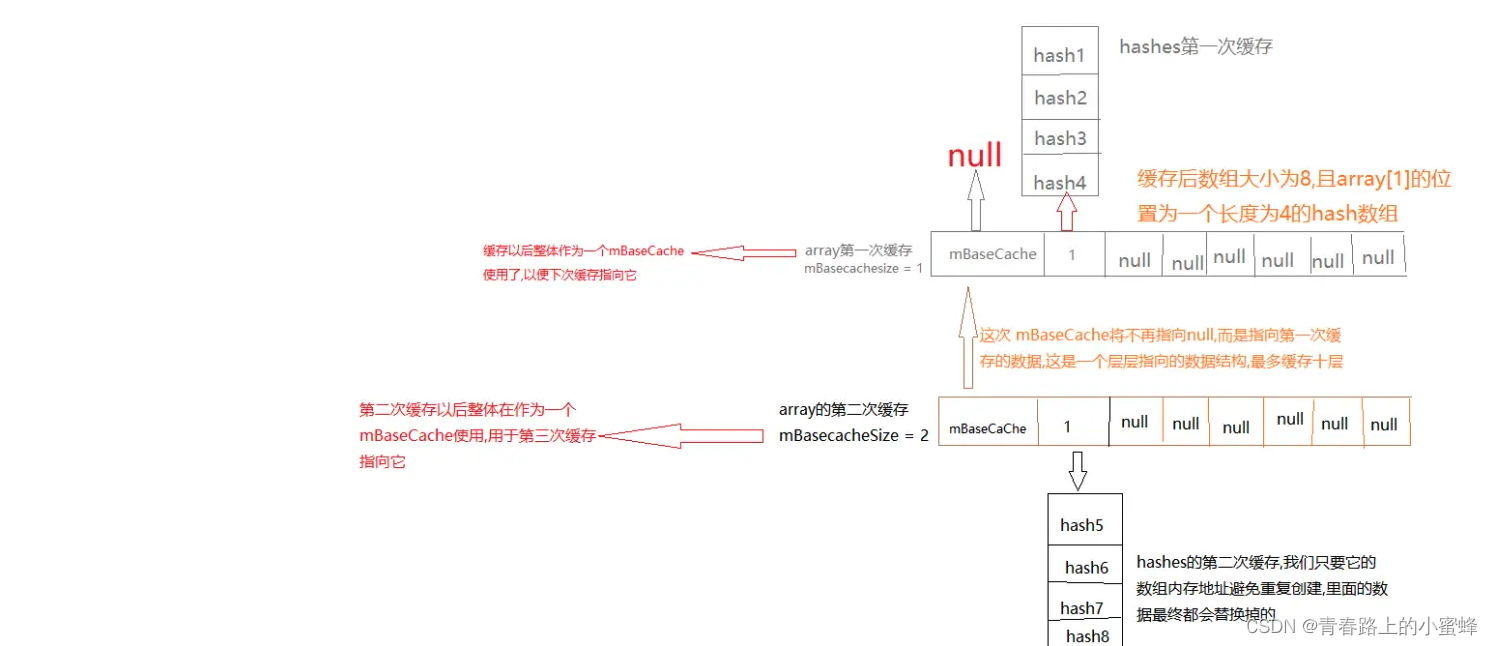一、数据结构
ArrayMap是一个key-value的数据结构,它比HashMap有更高的内存效率
它映射到两个数组结构:一个整数数组mHashes,用来保存key的hashcode;一个对象数组mArray,保存key-value

它不适用于大量数据的存储,通常会比HashMap慢,因为查找需要二分查找。
二、源码解析
public final class ArrayMap<K, V> implements Map<K, V> 由上面可知,ArrayMap是Map的子类
1、成员变量
//默认的最小容量
private static final int BASE_SIZE = 4;
//缓存的容量
private static final int CACHE_SIZE = 10;
//是否使用 System.identityHashCode(key)来获取hashcode
private final boolean mIdentityHashCode;
//存放key的hashcode的数组
int[] mHashes;
//按顺序存放key、value的数组
Object[] mArray;
//mHashes的大小
int mSize;
private MapCollections<K, V> mCollections;注意:mSize表示的是数组mHashes的大小,而mArray的大小为2*mSize。mHashes中升序存放key的hash值,mArray中顺序存储了key和value。若key的hash在mHashes的位置索引为index,那么key在mArray中的位置索引keyIndex=index<<1=index*2,value在mArray中的位置valueIndex=(index<<1)+1=index*2+1。
2、构造函数
public ArrayMap() {
this(0, false);
}
public ArrayMap(int capacity) {
this(capacity, false);
}
public ArrayMap(int capacity, boolean identityHashCode) {
mIdentityHashCode = identityHashCode;
if (capacity < 0) {
mHashes = EMPTY_IMMUTABLE_INTS;
mArray = EmptyArray.OBJECT;
} else if (capacity == 0) {
mHashes = EmptyArray.INT;
mArray = EmptyArray.OBJECT;
} else {
allocArrays(capacity);
}
mSize = 0;
}
ArrayMap提供了三种构造方法,其中第三个构造方法,从外部传入mHash数组的初始容量capacity。
- 如果capacity<0,那么mHashes就被赋值一个不可变的int数组,mArray被赋值一个空对象数组。
- 如果capacity=0,那么mHashes就被赋值一个空int数组,mArray被赋值一个空对象数组。
- 如果capacity>0,那么就会调用allocArray(capacity)方法,申请指定容量大小的数组。
3、元素查询
int indexOf(Object key, int hash) {
final int N = mSize;
// ====== TAG 01 ======
int index = binarySearchHashes(mHashes, N, hash);
if (index < 0) {
return index;
}
if (key.equals(mArray[index<<1])) {//走到这里,说明已经通过Hashcode找到对的key,这里再判断下查找到索引位置的key与要找的key是否相同,如果相同,则证明找到了,直接返回。如果不相同,则说明hash冲突了。
return index;
}
// ====== TAG 02 ======
for (end = index + 1; end < N && mHashes[end] == hash; end++) {
if (key.equals(mArray[end << 1])) return end;
}
for (int i = index - 1; i >= 0 && mHashes[i] == hash; i--) {
if (key.equals(mArray[i << 1])) return i;
}
return ~end;
}
ArrayMap查找元素主要是通过binarySearchHashes二分查找方式来查找index;若HashCode和Key均匹配则为要查找的index;若只有HashCode相同但对象不同(即HashCode冲突),则从当前对应的Index向后和向前分别遍历查找。(ArrayMap处理Hash冲突的解决办法就是,采用开放地址法,即如果hash值对应的index已经存在值了,则需要从index的两边去寻找与当前key匹配时对应的索引。如果没有找到,则表示当前key原本不存在,需要新插入进来,而插入的位置,就是有着相同hash值且连续的子数组序列的末尾位置)

4、元素添加
ArrayMap的元素添加有两个方法:put()和append()
(1)put()
public V put(K key, V value) {
final int osize = mSize;
final int hash;
int index;
if (key == null) {
hash = 0;
index = indexOfNull();
} else {
hash = mIdentityHashCode ? System.identityHashCode(key) : key.hashCode();
// ====== TAG 01 ======
index = indexOf(key, hash);
}
if (index >= 0) {
// ====== TAG 02 ======
index = (index<<1) + 1;
final V old = (V)mArray[index];
mArray[index] = value;
return old;
}
// ====== TAG 03 ======
index = ~index;
if (osize >= mHashes.length) {
final int n = osize >= (BASE_SIZE*2) ? (osize+(osize>>1)) : (osize >= BASE_SIZE ? (BASE_SIZE*2) : BASE_SIZE);
final int[] ohashes = mHashes;
final Object[] oarray = mArray;
// ====== TAG 04 ======
allocArrays(n);
if (CONCURRENT_MODIFICATION_EXCEPTIONS && osize != mSize) {
throw new ConcurrentModificationException();
}
// ====== TAG 05 ======
if (mHashes.length > 0) {
System.arraycopy(ohashes, 0, mHashes, 0, ohashes.length);
System.arraycopy(oarray, 0, mArray, 0, oarray.length);
}
freeArrays(ohashes, oarray, osize);
}
// ====== TAG 06 ======
if (index < osize) {
System.arraycopy(mHashes, index, mHashes, index + 1, osize - index);
System.arraycopy(mArray, index << 1, mArray, (index + 1) << 1, (mSize - index) << 1);
}
mHashes[index] = hash;
mArray[index<<1] = key;
mArray[(index<<1)+1] = value;
mSize++;
return null;
}
TAG 01:主要用于二分查找,在mHashes数组中查找HashCode相等的key
TAG 02:如果index>0说明已经找到,即有对应HashCode相等的Key,然后更新其Value值。
TAG 03:在index<0,说明没有找到,即没有对应的HashCode相等的Key,此时需要插入新数据。
这里需要注意下,会先判断是否需要扩容,如果mHashes数组已满,那么就需要调用allocArrays扩容,这里扩容的大小:
final int n = osize >= (BASE_SIZE*2) ? (osize+(osize>>1)) : (osize >= BASE_SIZE ? (BASE_SIZE*2) : BASE_SIZE);可以看出,如果扩容前的容量大小是否>=BASE_SIZE*2(即8),那么扩容为之前容量的1.5倍。如果扩容前容量小于8再判断之前容量是否>=4,如果>=4,那么扩容为8;如果<4那么扩容为4.
TAG 04:当需要扩容时,可采用allocArrays()方式分配更大的内存空间;
TAG 05:然后通过System.arraycopy将老的数组数据拷贝到新的数组中,再通过freeArrays()释放老的数组内存。
TAG 06:当需要插入的元素不在末尾时,拷贝完数据之后需要将index后移一位。
(2)append()
public void append(K key, V value) {
int index = mSize;
final int hash = key == null ? 0 : (mIdentityHashCode ? System.identityHashCode(key) : key.hashCode());
if (index >= mHashes.length) {
throw new IllegalStateException("Array is full");
}
if (index > 0 && mHashes[index-1] > hash) {
RuntimeException e = new RuntimeException("here");
e.fillInStackTrace();
// ====== TAG ======
put(key, value);
return;
}
mSize = index+1;
mHashes[index] = hash;
index <<= 1;
mArray[index] = key;
mArray[index+1] = value;
}
append方法会优先判断需要插入到的数组中的位置,如果要插入到的位置在mHashes数组的中间,则调用put方法,如果插入的位置在mHashes数组的末尾,直接在末尾处添加。
5、元素删除
public V remove(Object key) {
final int index = indexOfKey(key);
if (index >= 0) {
return removeAt(index);
}
return null;
}
public V removeAt(int index) {
final Object old = mArray[(index << 1) + 1];
final int osize = mSize;
final int nsize;
// ====== TAG 01 ======
if (osize <= 1) {
final int[] ohashes = mHashes;
final Object[] oarray = mArray;
mHashes = EmptyArray.INT;
mArray = EmptyArray.OBJECT;
freeArrays(ohashes, oarray, osize);
nsize = 0;
} else {
nsize = osize - 1;
// ====== TAG 02 ======
if (mHashes.length > (BASE_SIZE*2) && mSize < mHashes.length/3) {
final int n = osize > (BASE_SIZE*2) ? (osize + (osize>>1)) : (BASE_SIZE*2);
final int[] ohashes = mHashes;
final Object[] oarray = mArray;
allocArrays(n);
if (index > 0) {
System.arraycopy(ohashes, 0, mHashes, 0, index);
System.arraycopy(oarray, 0, mArray, 0, index << 1);
}
if (index < nsize) {
System.arraycopy(ohashes, index + 1, mHashes, index, nsize - index);
System.arraycopy(oarray, (index + 1) << 1, mArray, index << 1, (nsize - index) << 1);
}
} else {
// ====== TAG 03 ======
if (index < nsize) {
System.arraycopy(mHashes, index + 1, mHashes, index, nsize - index);
System.arraycopy(mArray, (index + 1) << 1, mArray, index << 1, (nsize - index) << 1);
}
mArray[nsize << 1] = null;
mArray[(nsize << 1) + 1] = null;
}
}
mSize = nsize;
return (V)old;
}
TAG 01:当数组只有一个要删除的元素时,直接将mHashes和mArray置空并通过freeArrays释放内存
TAG02:当数组内存大小大于8并且元素的数量少于1/3空间大小时,通过allocArrays进行减少分配内存
TAG03:当删除其中一个元素时,需要将该元素之后的所有元素向前移动一位
ArrayMap为了避免频繁的创建和销毁,提供了mBaseCache和mTwiceBaseCash两个数组缓冲池,同时提供了allocArrays和freeArrays内存分配和释放的方法,两者相互对应,都通过缓冲池分配和释放内存。
private void allocArrays(final int size) {
if (size == (BASE_SIZE*2)) {
synchronized (ArrayMap.class) {
if (mTwiceBaseCache != null) {
final Object[] array = mTwiceBaseCache;
mArray = array;
mTwiceBaseCache = (Object[])array[0];
mHashes = (int[])array[1];
array[0] = array[1] = null;
mTwiceBaseCacheSize--;
return;
}
}
} else if (size == BASE_SIZE) {
...
}
mHashes = new int[size];
mArray = new Object[size<<1];
}
当需要分配内存大小为BASE_SIZE或BASE_SIZE*2时,会先查看对应的缓存池中取出mArray和mHashes;其方式是先将缓存池指向上一条缓存地址,将缓存池的第 array[1] 个元素赋值为 mHashes ,再把 mArray 的第 array[0] 和第 array[1] 个位置的数据置为 null;
private static void freeArrays(final int[] hashes, final Object[] array, final int size) {
if (hashes.length == (BASE_SIZE*2)) {
synchronized (ArrayMap.class) {
if (mTwiceBaseCacheSize < CACHE_SIZE) {
array[0] = mTwiceBaseCache;
array[1] = hashes;
for (int i=(size<<1)-1; i>=2; i--) {
array[i] = null;
}
mTwiceBaseCache = array;
mTwiceBaseCacheSize++;
}
}
} else if (hashes.length == BASE_SIZE) {
...
}
}
当内存需要释放时,释放大小为 BASE_SIZE 或 BASE_SIZE * 2 时,会将数组加入到缓冲池中;其方式是先将原缓冲池和哈希数组分别指向 array 前两位,之后的元素全部置空,最后将缓存池的头部指向最新的数组位置;

三、HashMap和ArrayMap对比
1、查找效率
- HashMap因为其根据hashcode的值直接算出index,所以其查找效率是随着数组长度增大而增加的
- ArrayMap使用的是二分查找法,所以每当数组长度增加一倍时,就需要多进行一次判断,效率下降。
2.扩容数量
- HashMap初始值16个长度,每次扩容时,直接申请双倍的数组空间
- ArrayMap每次扩容时候,如果size长度大于8时申请size*1.5个长度,大于4小于8申请8个,小于4时申请4个。
- 这样比较,ArrayMap是申请了更少的内存空间,但是扩容的频率比较高。因此,如果数据量较大的时候,还是使用HashMap比较合适,因为其扩容次数要比ArrayMap少很多。
- ArrayMap没有实现Serializable,不便在Android bundle进行传输
- ArrayMap扩容比HashMap高效,因为HashMap扩容需要重新计算hash值和移动元素。而ArrayMap只需要拷贝。






















 521
521











 被折叠的 条评论
为什么被折叠?
被折叠的 条评论
为什么被折叠?








